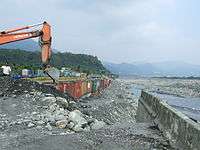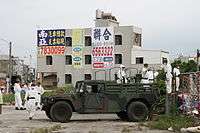Effects of Typhoon Morakot on Taiwan
Between August 6, 2009 and August 10, 2009, Taiwan was hit by Typhoon Morakot, which brought about unprecedented rainfall and flooding across the country. The incidents surrounding Typhoon Morakot are known as the Eight-Eight Flood (八八水災). The flooding is the most devastating flooding incident since the flooding caused by Typhoon Ellen in 1959. Typhoon Morakot is most remembered for the destruction of Siaolin Village in Jiasian, Kaohsiung.
According to the Government of the Republic of China, 681 people died and 18 people went missing due to the typhoon.[1] The Executive Yuan announced that all flags be placed at half mast between the August 22 to 24 in mourning.[2] The government was criticized for reacting slowly to the crisis, causing President Ma Ying-jeou's approval ratings to drop significantly and led to the resignation of Premier Liu Chao-shiuan[3]
Direct Effects
Nantou County

The most damage done to Nantou County was in Xinyi, which had the greatest rainfall in the county.[4] The currents of the Chenyoulan River caused the foundations of roads and buildings to be wiped away.[5] A building in Longhua Elementary School tilted 30 degrees as a result of the foundations being washed away and was on the verge of falling into the river.[6]
Provincial Highway 16 collapsed between Jiji and Shuili, causing seven cars to be washed into the Zhuoshui River. So far, only four out of fifteen bodies have been recovered.[7]
Tainan County
Typhoon Morakot caused Zengwen Reservoir, which was originally short on water, to suddenly exceed capacity.[8][9] In response to the excess water, the reservoir released over 100,000,000 liters of water, which is about 80% of the dam's total capacity.[10][11] The release of water caused severe flooding along the Zengwen River; in Xiaobei Village in Madou Township, the water level reached a story high.[12]
Kaohsiung County

Kaohsiung County saw over 2,500 millimeters of rainfall within three days (Kaohsiung typically receives the same amount of rain in a year). The rain brought severe floods on the plains and landslides in the mountains. On August 14, Xiaolin Village was completely covered due to an landslide, causing the deaths of 398 people.
Due to the rain, many bridges were washed away, including those on Provincial Highways 20, 21, and 27 and the bridge to the Maolin National Scenic Area. 14 people went missing after a weir under construction was washed away.[13]
Pingtung County
Pingtung County is one of the areas hardest hit by the typhoon. Due to the collapse of embankment along the Linbian River, there was severe flooding in Linbian and Jiadong, with Jiadong reporting flood depths of two stories. Embankments along the Laonong River also collapsed, causing flooding in Gaoshu. A bridge on Provincial Highway 24 collapsed, effectively cutting off Wutai Township from the rest of the country.
According to the Water Resources Agency, the area with the highest rainfall was in Wanluan Township with 135 millimeters per hour. The total highest rainfall was recorded in Sandimen Township with over 2500 millimeters.[14]
The railways in Pingtung also took a huge hit, with the Pingtung Line taking 6 months to repair.[15] Linbian Train Station's train tracks were entirely covered in mud after severe flooding there.[16]
Taitung County
Most of the flooding in Taitung County occurred in the south part of the county, with Daren, Taimali, and Dawu Townships being especially hard hit.
Flooding was especially serious in Zhiben Hot Springs, with 200 meters of its main road washed away. On August 9, the Jinshuai Hotel's (金帥溫泉大飯店) foundations were washed away, and the eight story hotel toppled over into the Zhiben River. Soon afterwards, the top three floors of the hotel were washed away.[17][18]
The TRA South Link Line was also hard hit, with two of its bridges being washed away in Taimali Township.[19] The Taimali River also flooded, destroying a large portion of Taihe Village in Taimali.[20][21]
Other counties
In Chaiyi County, embankments along the Bazhang and Puzi rivers collapsed, causing flooding in Puzi Township.[22] Since the coastal areas are lower in elevation, there was also widespread flooding in Dongshi, Budai, and Yizhu.[23] Many villages in Alishan, Meishan, Zhuqi townships saw flooding and destruction done to their infrastructure. The Alishan Forest Railway saw some serious damage, and repairs took about a year.[24][25]
Central and North Taiwan saw some less severe flooding, with the most serious in Dacheng and Erlin in Changhua County.
Losses
- Agriculture
- The Council of Agriculture estimates that a total of $19.217 billion NTD were lost due to the typhoon, making it the second costliest typhoon behind Typhoon Herb in 1996. Out of this, farms lost $12.9 billion, fisheries lost $4.7 billion, and livestock lost $1.6 billion.[26]
- Roads
- Twenty bridges were destroyed due to the typhoon, with eight being on a Provincial Highway. Seven of those on a highway were in Kaohsiung or Pingtung.[27][28][29] Additionally, at least 16 landslide dams were formed during the typhoon.[30][31][32]
- Railways
- Most of the damage done to railways are located in the south on the Pingtung, Taitung, and South Link lines. Also, the Alishan Forest Railway saw some serious damage.[33]
- Electricity
- Due to Typhoon Morakot, 896,833 houses lost power, and at least 850,000 houses lost their water supply.
[34][35][36]
- Education
- According to the Ministry of Education, 1,273 schools were affected by the typhoon, accumulating a loss of $1.87 billion NTD. The National Museum of Prehistory, National Science and Technology Museum, and Fonghuanggu Bird and Ecology Park were all damaged by the typhoon.
[37][38]
Emergency response

The military was dispatched with responding to the disasters all around the country with transporting food and aid around.[39] After the typhoon, soldiers were also used in cleanup and rebuilding.[40] An estimated 15,815 soldiers were used in total. With the assistance of firefighters and policemen, an estimated 41,752 people were rescued.[41]
On August 11, a helicopter delivering aid crashed in the mountains of Pingtung County. All three of its crew were lost.
Aftermath
Domestic Aid
On August 15, the Executive Yuan formed the "Typhoon Morakot Rebuilding Committee". The 37 person committee was given a budget of $116.5 million NTD to rebuild infrastructure and economic losses. The committee has built 3,481 permanent housing units in 40 locations and repaired most damaged roads.[42] However, there was controversy surrounding the relocation of people to these new housing units.[43]
After the flooding, many organizations began raising money for rebuilding in areas affected by the typhoon. Special programs were aired on national TV to fundraise. Additionally, a fundraising festival named "Spread the Love" was held, featuring prominent TV personalities Matilda Tao, Chang Hsiao-yen, and Shen Chun-hua. The event lasted for 7 hours and was aired on national TV and raised $500 million NTD.
Many large corporations also donated money to the cause, including Chi Mei, Evergreen, Delta Electronics, Foxconn, Formosa Plastics, TSMC, Cathay United Bank, and Asus. The Chunghua Post released a special edition stamp, with all proceeds going to helping rebuild.
Chinese Aid
The Association for Relations Across the Taiwan Straits donated a total of $450 million Renminbi ($2 billion RMB) to rebuild. They specified that $150 million TWD be used on building 500 units of recovery housing and $1.7 billion TWD be used on rebuilding infrastructure.[44]
The Mainland Affairs Council estimated that around $4 billion NTD was donated by China. Also, around $130 million NTD was donated by Taiwanese companies in China.[45][46][47]
See also
參考文獻
- ↑ "行政院莫拉克颱風災後重建推動委員會" (in Chinese). Archived from the original on 2010-02-11.
- ↑ "台灣將為颱風死者哀悼三天" (in Chinese). BBC中文網. 2009-08-20. Retrieved 2009-08-20.
- ↑ "八八究責/民調慘兮兮 馬施政滿意度僅剩16趴" (in Chinese). 東森新聞. 2009-08-19. Retrieved 2009-08-19.
- ↑ "土石流紅色警戒 南投全在信義鄉" (in Chinese). 中央社. 2009-08-08. Archived from the original on 2009-08-13. Retrieved 2009-08-08.
- ↑ "信義路斷 三千餘人受困山區" (in Chinese). 自由時報. 2009-08-11. Archived from the original on 2009-08-13. Retrieved 2009-08-12.
- ↑ "危急!溪水淘空 隆華國小傾斜30度" (in Chinese). TVBS. 2009-08-11. Retrieved 2009-08-12.
- ↑ "八八水災/尋車尋人 台16線濁水溪河床瀰漫屍臭味" (in Chinese). 華視新聞. 2009-08-08. Archived from the original on 2009-08-14. Retrieved 2009-08-13.
- ↑ "「八八水災/曾文洩洪成箭靶 水利署:不洩洪29鄉鎮恐泡湯」" (in Chinese). NOWnews. 2009-08-10. Retrieved 2009-08-11.
- ↑ "「莫拉克颱風/曾文水庫晚上8點30分洩洪」" (in Chinese). NOWnews. 2009-08-08. Retrieved 2009-08-11.
- ↑ 曾文水庫 水文資料表, 南區水資源局
- ↑ 曾文溪善化段潰堤 蘇煥智籲中央助搶修 Archived 2010-07-04 at the Wayback Machine.,自由時報
- ↑ "范道南基金會 捐3800個便當". 民眾日報. 2009-08-12. Retrieved 2009-08-28.
- ↑ "莫拉克/荖濃溪暴漲 堤防潰堤大津橋斷" (in Chinese). TVBS. 2009-08-09. Retrieved 2009-08-09.
- ↑ "莫拉克屏東發威 佳冬塭豐積水2樓高" (in Chinese). 中央社. 2009-08-08. Archived from the original on 2009-08-13. Retrieved 2009-08-08.
- ↑ "台鐵南下只到新營 南迴停駛至少3個月" (in Chinese). 聯合報. 2009-08-09. Retrieved 2009-08-09.
- ↑ "林邊火車站污泥比車高 步步難" (in Chinese). 民視. 2009-08-12. Retrieved 2009-08-13.
- ↑ "莫拉克/〈快訊〉垮了!知本金帥飯店 橫躺溪谷" (in Chinese). TVBS. 2009-08-09. Retrieved 2009-08-09.
- ↑ YouTuBe-金帥飯店倒塌畫面
- ↑ "台鐵南下只到新營 南迴停駛至少3個月" (in Chinese). 聯合報. 2009-08-10. Retrieved 2009-08-10.
- ↑ "太麻里淹大水 「我家被沖進太平洋了!」" (in Chinese). 聯合報. 2009-08-09. Retrieved 2009-08-13.
- ↑ "莫拉克颱風/汪洋一片! 台東太麻里災情50年來之最" (in Chinese). NOWnews. 2009-08-08. Retrieved 2009-08-13.
- ↑ "朴子溪、八掌溪潰堤 嘉縣逾萬人受困" (in Chinese). 自由時報電子報. 2009-08-09. Archived from the original on 2009-08-12. Retrieved 2009-08-18.
- ↑ "路斷廿多條 救災難" (in Chinese). 中國時報. 2009-08-11. Retrieved 2009-08-13.
- ↑ "直升機一飛來 大家抱一起哭" (in Chinese). 聯合晚報. 2009-08-13. Retrieved 2009-08-13.
- ↑ "風災意外/中埔土石流 母子2屍尋獲" (in Chinese). 聯合報. 2009-08-12. Retrieved 2009-08-16.
- ↑ "災後重建區產業重建計畫" (PDF) (in Chinese). 行政院莫拉克颱風災後重建推動委員會. Archived from the original (PDF) on 2013-06-02. Retrieved 2013-04-19.
- ↑ "風災初估20橋斷裂 比921更慘" (in Chinese). 聯合報. 2009-08-10. Retrieved 2009-08-10.
- ↑ 公路總局 公路防救災管理系統/沖毀橋樑一覽表
- ↑ "全台20橋斷 比921慘" (in Chinese). 蘋果日報. 2009-08-10. Retrieved 2009-08-10.
- ↑ "17堰塞湖4處警戒" (in Chinese). 中國時報. 2009-08-15. Retrieved 2009-08-15.
- ↑ "高東屏5堰塞湖 嚴密監測" (in Chinese). 自由電子報. 2009-08-15. Archived from the original on 2009-09-17. Retrieved 2009-08-15.
- ↑ "10多處堰塞湖 成恐怖炸彈" (in Chinese). 民視新聞網. 2009-08-14. Retrieved 2009-08-15.
- ↑ 八八水災/阿里山鐵路崩塌290處 修復得花2年光景,東森新聞
- ↑ "許添財要求中央加派水車支援". 民眾日報. 2009-08-13. Retrieved 2009-08-30.
- ↑ "莫拉克颱風襲台,南化無法出水台南縣曾文溪以南鄉鎮市及台南市全部停水" (in Chinese). 台南市政府網站. 2009-08-09. Archived from the original on 2009-08-13. Retrieved 2009-08-10.
- ↑ "莫拉克重創高屏堰 北高雄停水3天" (in Chinese). 中央社. 2009-08-10. Archived from the original on 2016-03-04. Retrieved 2009-08-13.
- ↑ "教科書泡水 教部協助學校負責到底" (in Chinese). 國立教育廣播電台. 2009-08-12. Retrieved 2009-08-12.
- ↑ "學校災損 竄升至1273校、187億元" (in Chinese). 聯合報. 2009-08-13. Retrieved 2009-08-13.
- ↑ 青年日報 Archived 2009-09-22 at the Wayback Machine.
- ↑ 莫拉克颱風災害應變處置報告第74報 Archived 2010-01-31 at the Wayback Machine.
- ↑ "救災急先鋒 張瑞賢英勇捨身令人敬佩" (in Chinese). 自由時報電子報. 2009-08-14. Archived from the original on 2009-09-23. Retrieved 2009-08-15.
- ↑ "行政院莫拉克颱風災後重建推動委員會 - 執行長的話" (in Chinese). 行政院莫拉克颱風災後重建推動委員會. 2013-02-18. Archived from the original on 2013-05-02. Retrieved 2013-04-17.
- ↑ 鐘聖雄 (2013-03-05). "回家真好" (in Chinese). PNN公視新聞議題中心. Archived from the original on 2016年2月1日. Retrieved 2013-04-17. Check date values in:
|archive-date=(help) - ↑ 海協會捐助莫拉克風災災區重建款項於1月21日送交內政部賑災專戶
- ↑ 八八水災大陸捐款 台灣實收已逾新台幣33億 2010-08-26 17:45:23
- ↑ 陸委會:八八水災大陸捐款約40億元中廣新聞網 2010-08-27
- ↑ 台企聯捐款千萬給海基會轉捐內政部